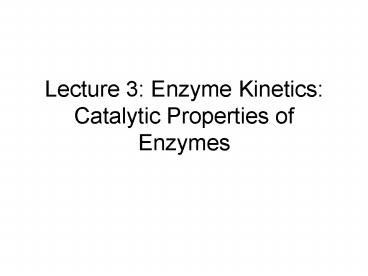Lecture 3: Enzyme Kinetics: Catalytic Properties of Enzymes - PowerPoint PPT Presentation
1 / 18
Title:
Lecture 3: Enzyme Kinetics: Catalytic Properties of Enzymes
Description:
Mg, Ca, Zn, Fe etc.) are thought to be bound to ~1/3 of all proteins and can ... that you will see in this course include, for example, iron-sulfur clusters, ... – PowerPoint PPT presentation
Number of Views:246
Avg rating:3.0/5.0
Title: Lecture 3: Enzyme Kinetics: Catalytic Properties of Enzymes
1
Lecture 3 Enzyme Kinetics Catalytic Properties
of Enzymes
2
What is a catalyst?
A catalyst accelerates a chemical reaction
It participates in the reaction but is not
consumed, meaning that is must return to its
original state after the chemical reaction has
been catalyzed. A catalyst can be a simple
inorganic compound or a biological macromolecule
called an enzyme (most often protein, but also
can by RNA).
3
What sort of rate acceleration can catalysts
provide?
Consider the reaction
Relative rate Uncatalyzed 1
Pt Black (inorganic catalyst) 10,000
catalase (enzyme) 300,000,000,000
4
How do catalysts work?
5
The rate of a chemical reaction is an exponential
function of activation energy
6
ATP hydrolysis as an example
7
Does an enzyme only catalyze the forward
reaction? NO!
Why not? Because the free energy difference
between reactants and products of a reaction and
the starting concentration of each determines the
direction (more on this later).
8
Catalysts DO NOT alter the final equilibrium
distribution of reactants and products in a
chemical reaction, they merely reduce the amount
of time required to attain the equilibrium
distribution.
9
How do enzymes do the amazing things they do?
Biological enzymes have evolved to form complex
three-dimensional structures that present an
active site surface to which reactants in a
chemical reaction bind. These sites also
position amino acid R-groups and/or reaction
cofactors (such as metals) or prosthetic groups
at the appropriate positions to aid in
catalysis. Two major models for how this might
work on the structural level are shown on the
next slide.
10
Two models for ES complex
11
Lets take a look at a real active site!
ATP
Mg(2)
12
Summary of major properties of enzymes
13
How does one measure enzyme activity?
14
How does enzyme influence observed reaction
velocity?
1 x enzyme DP/Dt 1
P
Assumes that E is limiting and that the
uncatalyzed reaction rate is 0
time
15
Specificity of enzymes
How specific are enzymes for a given
substrate? The answer depends upon the enzyme
youre talking about. Most enzymes are highly
specific, acting on only a small number of
substrates that are highly similar in structure.
Others, such as alkaline phosphatase mentioned in
your notes, are less specific. Specificity
arises from structural and chemical
complementarity between the substrate and its
enzyme.
16
Specificity of enzymes (an example)
Hydrogen Bonds Gln with Adenine
Mg (2)
Ionic Bonds
Asp with Mg(2), Lys with Phosphates
17
Metals, coenzymes, and prosthetics groups
Many enzymes bind non-protein cellular components
that are used as key factors in the enzyme
activity. These fall into three basic
categories (1) Metals Metals (e.g. Mg, Ca, Zn,
Fe etc.) are thought to be bound to 1/3 of all
proteins and can play key roles in activity. An
example is the Mg(2) in the ATPase on the
previous slide. These ions can confer a wider
array of chemical properties to proteins over
those of the 20 natural amino acids.
18
Metals, cofactors, and prosthetics groups
(2 3) Coenzymes and prosthetic groups
Low-molecular organic compounds that bind either
weakly (coenzymes) or tightly (prosthetic groups)
to the protein. Examples that you will see in
this course include, for example, iron-sulfur
clusters, heme, and coenzyme A.

















![Lecture 3: Factors affecting enzyme activity: [substrate] and inhibitors PowerPoint PPT Presentation](https://s3.amazonaws.com/images.powershow.com/A1258150516nKkIo.th0.jpg?_=20140110065)













